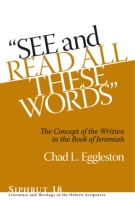
“See and Read All These Words”
The Concept of the Written in the Book of Jeremiah
Chad L. Eggleston
“See and Read All These Words”
The Concept of the Written in the Book of Jeremiah
Chad L. Eggleston
Unusually for the Hebrew Bible, the book of Jeremiah contains a high number of references to writers, writing, and the written word. The book (which was primarily written during the exilic period) demonstrates a key moment in the ongoing integration of writing and the written word into ancient Israelite society. Yet the book does not describe writing in the abstract. Instead, it provides an account of its own textualization, thereby blurring the lines between the texts in the narrative and the texts that constitute the book. Scrolls in Jeremiah become inextricably intertwined with the scroll of Jeremiah.
- Description
- Table of Contents
To authenticate the book of Jeremiah as the word of YHWH, its tradents present a theological account of the chain of transmission from the divine to the prophet and then to the scribe and the written page. Indeed, the book of Jeremiah extends the chain of transmission beyond the written word to include the book of Jeremiah itself and, finally, a receiving audience. To make the case for this chain of transmission, See and Read’s three exegetical chapters attend to writers (YHWH, prophets, and scribes), the written word, and the receiving audience.
The first exegetical chapter describes the standard chain of transmission from the divine to the prophet to the scribe, demonstrating that all three agents in this chain are imagined as writers and that writing was increasingly understood as a suitable conduit for the divine word. The second exegetical chapter attends to the written word in Jeremiah, especially Jeremiah’s self-references (e.g., “in this book”, “all these words”) as a pivotal element in the extension of the chain of transmission beyond the words in the text to the words of the text. Finally, the third exegetical chapter considers the construction of the audience in the book of Jeremiah, concluding that the written word, as Jeremiah imagines it, is to be received by a worshiping audience through public reading but delivered via textual intermediaries.
Introduction
See and Read
On “Theology” and “Religion”
1. Writing/Righting the Written in Jeremiah
Writing as Degeneration
Writing as Progress
Writing as Dictation
Writing as Deconstruction
Righting the Written in Jeremiah
2. Inscribing Writers in the Book of Jeremiah
The Chain of Transmission
Scribes as Writers
Prophets as Writers
Divine Writers
Summary
3. Inscribing the Written in the Book of Jeremiah
Scrolls within Jeremiah’s Represented World
Scrolls beyond Jeremiah’s Represented World
Jeremiah’s Account of Textual Inscription
4. Inscribing Audiences in the Book of Jeremiah
Audiences in the Book of Jeremiah
Audiences of the Book of Jeremiah
Conclusion
A Theological Account of Writing in Jeremiah
Avenues for Further Research
Bibliography
Index of Authors
Index of Scripture
Mailing List
Subscribe to our mailing list and be notified about new titles, journals and catalogs.



